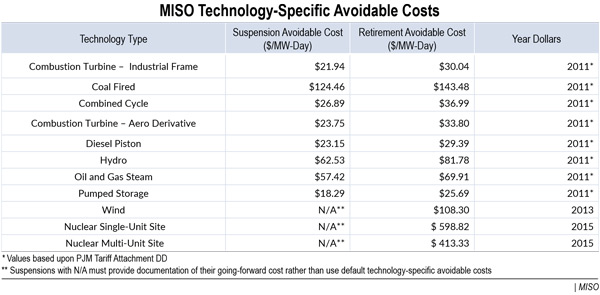By Amanda Durish Cook
MISO can use PJM’s technology-specific reference levels for market mitigation in its 2017/18 capacity auction, FERC has decided.
The commission’s Dec. 28 order said MISO’s use of PJM’s numbers “strikes a fair balance between reducing the burden of demonstrating and verifying facility-specific reference levels, and allowing a market participant to select the default technology-specific avoidable costs that best reflect its actual avoidable costs” (ER16-833-003).
Reference levels are intended to represent the non-fuel costs of operating different types of generation resources. Similar to a cost-based offer in the energy market, they will be used as a resource’s capacity offer when a capacity seller fails MISO’s market power tests.
MISO’s proposal was in response to FERC’s December 2015 ruling that the RTO’s use of estimated opportunity costs for exporting power into PJM resulted in excessive mitigated cost levels. (See FERC Orders MISO to Change Auction Rules.)
The commission ordered MISO to set the initial reference for offers into the capacity auction at $0/MW-day. Because the commission said the $0 default might generate more requests from capacity suppliers to establish facility-specific reference levels, the commission called for the technology-specific defaults to reduce the need to verify costs on a unit-by-unit basis (EL15-70, et al.).
MISO’s staff and Independent Market Monitor agreed to base the mitigation levels on PJM’s avoided cost numbers because the generation technologies in the two RTOs are similar and PJM’s values are already FERC-approved. (See MISO Moves Forward on Auction Design; Seasonal Filing Delayed Again.)
MISO’s approach diverges from PJM on several points, including use of the monthly Consumer Price Index to update values rather than the Handy-Whitman index. Because PJM’s figures do not include defaults for wind and nuclear generators, MISO developed its cost estimates based on data from the Energy Information Administration and the Nuclear Energy Institute, respectively.
MISO also will not include the 10% “adder” PJM uses to offset the uncertainty of estimating costs three years into the future. The commission rejected NRG Energy’s request that MISO be required to use the adder. Unlike PJM’s three-year forward auction, FERC said, MISO’s prompt auction does not require the same safeguard.
FERC also mandated separate values for multi-unit and single-unit nuclear resources, despite Exelon’s comments that the two values were not materially different.
FERC ordered MISO to review the reference levels every three years, rejecting the RTO’s proposal to update values only after PJM updated its own numbers. FERC said MISO’s review of its avoidable costs “should not be contingent upon the review schedule of another regional transmission organization.”
FERC’s order also approved MISO’s proposal that market participants intending to retire or suspend a unit must use either retirement- or mothball-based default avoidable costs, respectively. FERC said market participants wishing to take advantage of the retirement-specific values must have already submitted a notification of retirement to MISO. However, since MISO only included retirement-based and not mothball-based values for nuclear and wind units, FERC ordered the RTO to provide wind and nuclear mothball-based avoidable costs or explain why they should be exempted.




